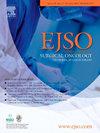机器人与腹腔镜重复肝切除术:围手术期结果的单中心比较研究。
IF 3.5
2区 医学
Q2 ONCOLOGY
引用次数: 0
摘要
目的:重复肝脏切除术被认为是一项具有技术挑战性的手术,因此通常首选开放式方法。随着微创肝脏手术的引入,腹腔镜重复肝脏切除术取得了良好的效果,但机器人重复肝脏切除术的数据有限。我们的目的是比较机器人和腹腔镜重复肝切除术:在一项单中心回顾性分析中,我们报告了 2011 年 9 月至 2023 年 8 月期间进行的所有微创重复肝切除术的数据。我们比较了腹腔镜方法和机器人方法的短期疗效,包括手术时间、失血量、转归率、发病率和死亡率:共进行了136例微创重复肝切除术,其中机器人手术56例,腹腔镜手术80例。两组患者的基线人口统计学、诊断和手术过程相似。虽然机器人手术组的平均手术时间略长15分钟(145分钟和130分钟,P = 0.04),但机器人手术组的中位失血量明显更低(30毫升和80毫升,P 结论:机器人手术组的平均手术时间略长15分钟(145分钟和130分钟,P = 0.04),但机器人手术组的中位失血量明显更低(30毫升和80毫升,P = 0.04):机器人方法用于微创重复肝脏手术既安全又可行,同时还显示出良好的短期疗效。根据我们的经验,"隧道技术 "可避免腹腔内粘连的剥离,是这种方法的主要优势。本文章由计算机程序翻译,如有差异,请以英文原文为准。
Robotic versus laparoscopic repeat hepatectomy: A comparative single-center study of perioperative outcomes
Purpose
A repeat liver resection is considered a technically challenging procedure and therefor an open approach is frequently preferred. With the introduction of minimally invasive liver surgery, laparoscopic repeat liver resection demonstrates favorable results, however, limited data on robotic repeat liver resections exists. Our aim is to compare the robotic approach with the laparoscopic one for a repeat liver resection.
Methods
In a single-center retrospective analysis, we report the data of all minimally invasive repeat liver resections performed between September 2011 and August 2023. Short-term outcomes – including procedure time, blood loss, conversion rate, morbidity and mortality – were compared for a laparoscopic and a robotic approach.
Results
A total of 136 minimally invasive repeat liver resections were performed, of which 56 robotic procedures and 80 laparoscopic procedures. Both groups were similar in baseline demographics, diagnosis and surgical procedure. While the mean procedure time was slightly longer in the robotics group by 15 min (145min and 130min, p = 0.04), the median blood loss was significantly lower in the robotic group (30 ml and 80 ml, p < 0.001). Additionally, there was a trend towards less conversions in the robotic group (n = 0 and n = 6, p = 0.42). Post-operative morbidity and mortality were similar in both groups.
Conclusion
The robotic approach for minimally invasive repeat liver surgery is both safe and feasible, while also demonstrating favorable short-term outcomes. In our experience, the ‘tunnel technique’ – which avoids dissection of intra-abdominal adhesions – is a key advantage of this approach.
求助全文
通过发布文献求助,成功后即可免费获取论文全文。
去求助
来源期刊

Ejso
医学-外科
CiteScore
6.40
自引率
2.60%
发文量
1148
审稿时长
41 days
期刊介绍:
JSO - European Journal of Surgical Oncology ("the Journal of Cancer Surgery") is the Official Journal of the European Society of Surgical Oncology and BASO ~ the Association for Cancer Surgery.
The EJSO aims to advance surgical oncology research and practice through the publication of original research articles, review articles, editorials, debates and correspondence.
 求助内容:
求助内容: 应助结果提醒方式:
应助结果提醒方式:


